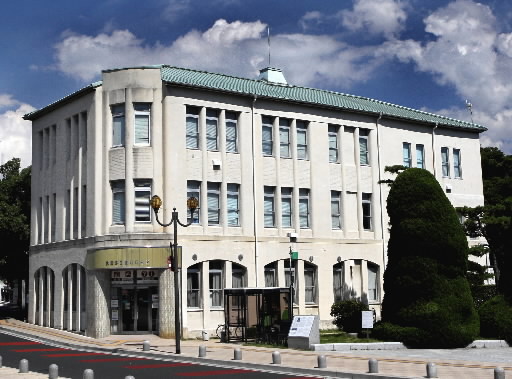- A-bomb Images
- Landmarks of Hiroshima: Rest House
Landmarks of Hiroshima: Rest House
by Kenji Namba, Senior Staff Writer
At the western corner of the Motoyasu Bridge, which links Hiroshima Peace Memorial Park with the Hondori shopping district, stands a reinforced concrete building of three floors and a basement. The building is now called the Rest House, but it was known by three other names in the past. The history of the building dates back to 1929.
The building was originally constructed to house the Taishoya Kimono Shop. With arch-shaped show windows, the building faced the Nakajima Hondori shopping street and stood in one of Hiroshima's liveliest districts of the time, with rows of shops, cafes and movie theaters. The modern-looking kimono shop, along with the Hiroshima Prefectural Industrial Promotion Hall (the present-day Atomic Bomb Dome), located on the opposite bank of the river, drew much attention.
But the shop was forced to close in 1943 after war broke out between Japan and the United States. The Hiroshima Prefectural Fuel Rationing Union purchased the building and turned it into the Fuel Hall in 1944. On August 6, 1945, the atomic bomb exploded in the sky about 170 meters northeast of the building. Thirty-seven employees were in the building at the time. All of them, except Eizo Nomura, 47 years old when the bombing occurred, died in the blast. Mr. Nomura was down in the basement to retrieve some documents and survived the explosion.
Though its roof and portions of the walls were severely damaged, the building avoided collapse and was renovated after the war. It was then used by the City of Hiroshima as an office for reconstruction efforts in the area. Since 1982, it has served as the Rest House.
The demolition of the A-bombed building, standing in close proximity to the hypocenter, has been considered several times. When Peace Memorial Park was established in the early 1950s, and the new Motoyasu Bridge was constructed in the early 1990s, debate arose over whether or not the building should be preserved. In 1995, the city announced that the building would be demolished, but this plan was set aside, in part because the A-bomb Dome became listed as a World Heritage site.
On the first floor of the Rest House is a tourist information office and a souvenir shop. If visitors fill in a form, they can enter the basement as well.
(Originally published on August 8, 2011)
Rest House in Peace Memorial Park is A-bomb survivor
At the western corner of the Motoyasu Bridge, which links Hiroshima Peace Memorial Park with the Hondori shopping district, stands a reinforced concrete building of three floors and a basement. The building is now called the Rest House, but it was known by three other names in the past. The history of the building dates back to 1929.
The building was originally constructed to house the Taishoya Kimono Shop. With arch-shaped show windows, the building faced the Nakajima Hondori shopping street and stood in one of Hiroshima's liveliest districts of the time, with rows of shops, cafes and movie theaters. The modern-looking kimono shop, along with the Hiroshima Prefectural Industrial Promotion Hall (the present-day Atomic Bomb Dome), located on the opposite bank of the river, drew much attention.
But the shop was forced to close in 1943 after war broke out between Japan and the United States. The Hiroshima Prefectural Fuel Rationing Union purchased the building and turned it into the Fuel Hall in 1944. On August 6, 1945, the atomic bomb exploded in the sky about 170 meters northeast of the building. Thirty-seven employees were in the building at the time. All of them, except Eizo Nomura, 47 years old when the bombing occurred, died in the blast. Mr. Nomura was down in the basement to retrieve some documents and survived the explosion.
Though its roof and portions of the walls were severely damaged, the building avoided collapse and was renovated after the war. It was then used by the City of Hiroshima as an office for reconstruction efforts in the area. Since 1982, it has served as the Rest House.
The demolition of the A-bombed building, standing in close proximity to the hypocenter, has been considered several times. When Peace Memorial Park was established in the early 1950s, and the new Motoyasu Bridge was constructed in the early 1990s, debate arose over whether or not the building should be preserved. In 1995, the city announced that the building would be demolished, but this plan was set aside, in part because the A-bomb Dome became listed as a World Heritage site.
On the first floor of the Rest House is a tourist information office and a souvenir shop. If visitors fill in a form, they can enter the basement as well.
(Originally published on August 8, 2011)







